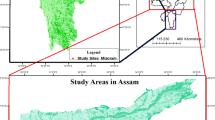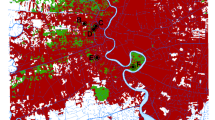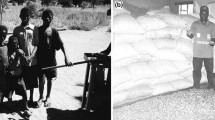Abstract
Mangifera sylvatica Roxb. is an underutilized wild tree species valued for its fruit, timber and medicine. It was believed to be widely grown in sub-tropical forests of Bangladesh, but nowadays can be seen only sparsely. Even though it has multiple uses, only the indigenous people in hilly areas use the fruit of this species, for cooking and making pickles. This study was designed to (1) observe the population status of M. sylvatica in the forests of south-eastern Bangladesh, (2) evaluate domestication potentiality through seed germination and early growth of seedlings, and (3) assess its suitability for small-scale forestry. Through 16 field visits in eight forest beats, 66 individual trees were identified and their GPS (global positioning system) coordinates were recorded. A seed germination rate of 83 % at 6 weeks after direct sowing was attained. The early growth of seedlings with fertilizer treatments showed no remarkable difference with seedlings without fertilization. The seed germination rate and early growth of seedlings indicates that this species can be easily domesticated and be incorporated into small-scale plantation programs. In that it has multiple use values, this species warrants promotion in small-scale forestry programs for conservation and benefiting the villagers.



Similar content being viewed by others
References
Baul TK, Hossain MM, Mezbahuddin M, Mohiuddin M (2011) Vegetative propagation of Litsea monopetala, a wild tropical medicinal plant: effects of indole-3-butyric acid (IBA) on stem cuttings. J For Res 22(3):409–416
Chowdhury MQ, Sarker SK, Deb JC, Sonet SS (2013) Timber species grouping in Bangladesh: linking wood properties. Wood Sci Technol 47(4):797–813
Das DK (1987) Edible fruits of Bangladesh Forests. Bulletin-3, Plant Taxonomy Series, Bangladesh Forest Research Institute, Chittagong, Bangladesh
Das DK, Alam MK (2001) Trees of Bangladesh. Bangladesh Forest Research Institute, Chittagong
Das S, Mohiuddin M (2012) Gender role in home garden management in the indigenous community: a case study in Bandarban hill district, Bangladesh. Int J Soc For 5(1):22–37
Das N, Nekaris KAI, Bhattacharjee PC (2014) Medicinal plants exudativory by the Bengal slow loris Nycticebus bengalensis. Endanger Species Res 23(2):149–157
Eiadthong W, Yonemori K, Sugiura A, Utsunomiya N, Subhadrabandhu S (1999) Analysis of phylogenetic relationships in Mangifera by restriction site analysis of an amplified region of cpDNA. Sci Hortic 80(3–4):145–155
Eiadthong W, Yonemori K, Kanzaki S, Sugiura A (2000) Amplified fragment length polymorphism analysis for studying genetic relationships among Mangifera species in Thailand. J Am Soc Hortic Sci 125(2):160–164
Gan KS, Lim SC, Choo KT (1998) Timber notes—light hardwoods II. Timber Technology. Bulletin 10, Forest Research Institute, Malaysia
Gilman EF, Yeager TH, Kent D (2000) Fertilizer rate and type impacts magnolia and oak growth in sandy landscape soil. J Arboric 26(3):177–182
Khan MS, Rahman MM, Ali AA (2001) Red data book of vascular plants of Bangladesh. Bangladesh National Herbarium, Dhaka
Kostermans AJGH, Bompard JM (1993) The mangoes: their botany, nomenclature, horticulture and utilization. IBPGR Academic Press, London
Krishna H, Singh SK (2007) Biotechnological advances in mango (Mangifera indica L.) and their future implication in crop improvement—a review. Biotechnol Adv 25(3):223–243
Kumar A, Solanki GS (2008) Population status and conservation of capped Langurs (Trachypithecus pileatus) in and around Pakke Wildlife Sanctuary, Arunachal Pradesh, India. Primate Conserv 23:97–105
Lim TK (2012) Edible medicinal and non-medicinal plants, volume 1 (Fruits). Springer, Dordrecht
Majumdar K, Datta BK (2015) Vegetation types, dominant compositions, woody plant diversity and stand structure in Trishna wildlife sanctuary of northeast India. J Environ Biol 36(2):409–418
Malik SK, Chaudhury R, Dhariwal OP, Bhandari DC (2010) Genetic resources of tropical underutilized fruits in India. NBPGR, New Delhi
Nishiyama K, Choi YA, Honsho C, Eiadthong W, Yonemori K (2006) Application of genomic in situ hybridization for phylogenetic study between Mangifera indica L. and eight wild species of Mangifera. Sci Hortic 110(1):114–117
Paul A (2013) Minor and uncultivated fruits of eastern India. Paper presented at the 2nd international symposium on minor fruits and medicinal plants for better lives. 20th Dec 2013, University of Ruhuna, Mapalana, Srilanka. http://www.permaculturenews.org/files/ISMF_MP_Srilanka-libre.pdf. Accessed 10 May 2015
Rahim MA, Alam AKMA, Alam MS, Anwar MM (2011) Underutilized fruits in Bangladesh. BAU-GPC, Bangladesh Agricultural University, Mymensingh, Bangladesh; International Malalysia and Rural Development Administration (RDA), Korea
Sundriyal M, Sundriyal RC (2001a) Wild edible plants of the Sikkim Himalaya: nutritive values of selected species. Econ Bot 55(3):337–390
Sundriyal M, Sundriyal RC (2001b) Seed germination and response of stem cutting to hormonal treatment in six priority wild edible fruit species of Sikkim Himalaya. Indian For 127(6):695–706
Sundriyal M, Sundriyal RC (2003) Underutilized edible plants of the Sikkim Himalaya: need for domestication. Curr Sci 85(6):731–736
Yonemori K, Honsho C, Kanzaki S, Eiadthong W, Sugiura A (2002) Phylogenetic relationships of Mangifera species revealed by ITS sequences of nuclear ribosomal DNA and a possibility of their hybrid origin. Plant Syst Evol 231(1–4):59–75
Acknowledgments
The authors are thankful to local people, forest officials and nursery staff in study areas for their kind time and assistance during fieldwork. Comments of two anonymous reviewers are greatly appreciated.
Author information
Authors and Affiliations
Corresponding author
Rights and permissions
About this article
Cite this article
Baul, T.K., Jahedul Alam, M. & Nath, T.K. Mangifera sylvatica Roxb. in the Forests of South-Eastern Bangladesh: A Potential Underutilised Tree for Small-Scale Forestry. Small-scale Forestry 15, 149–158 (2016). https://doi.org/10.1007/s11842-015-9314-x
Accepted:
Published:
Issue Date:
DOI: https://doi.org/10.1007/s11842-015-9314-x




